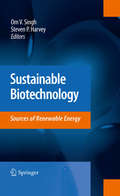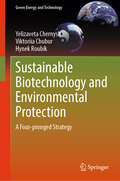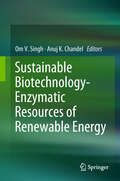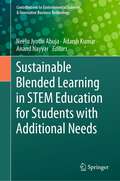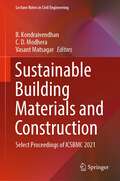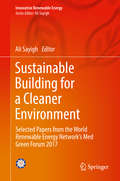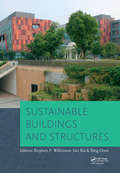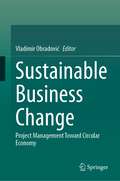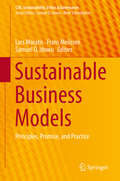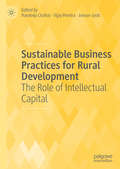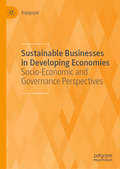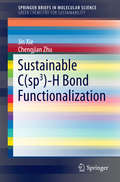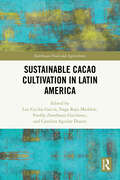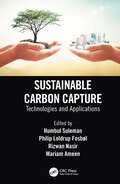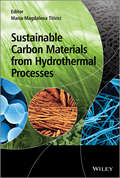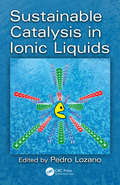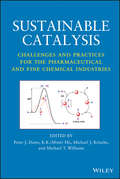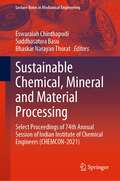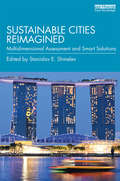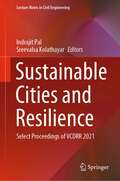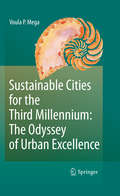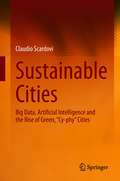- Table View
- List View
Sustainable Biotechnology
by Om V. Singh Steven P. HarveySustainable Biotechnology; Sources of Renewable Energy draws on the vast body of knowledge about renewable resources for biofuel research, with the aim to bridge the technology gap and focus on critical aspects of lignocellulosic biomolecules and the respective mechanisms regulating their bioconversion to liquid fuels and other value-added products. This book is a collection of outstanding research reports and reviews elucidating several broad-ranging areas of progress and challenges in the utilization of sustainable resources of renewable energy, especially in biofuels.
Sustainable Biotechnology and Environmental Protection: A Four-pronged Strategy (Green Energy and Technology)
by Yelizaveta Chernysh Viktoriia Chubur Hynek RoubíkThis book explores the critical role of biotechnology in addressing today’s most pressing environmental challenges. The book presents a comprehensive four-pronged strategy focused on minimizing waste, reducing toxicity, improving waste disposal, and transforming waste into valuable resources. With a special emphasis on sustainable bioeconomy approaches, it highlights the potential of biotechnological innovations in urban development and environmental protection. The book also addresses the impact of policies and regulations, offering a holistic view of how biotechnology can pave the way for a safer and more sustainable future.
Sustainable Biotechnology- Enzymatic Resources of Renewable Energy
by Om V. Singh Anuj K. ChandelNature offers abundant renewable resources that can be used to partially replace fossil fuels and commodity chemicals but issues of cost, technology readiness levels, and compatibility with existing distribution networks remain huge challenges. Cellulosic ethanol and biodiesel are the most immediately obvious target fuels, with hydrogen, methane and butanol as other potentially viable products. This book continues to bridge the technology gap and focus on critical aspects of lignocellulosic biomolecules and the respective mechanisms regulating their bioconversion to liquid fuels into energy and value-added products of industrial significance. This book is a collection of reviews elucidating several broad-ranging areas of progress and challenges in the utilization of sustainable resources of renewable energy, especially in biofuels. This book comes just at a time when government and industries are accelerating their efforts in the exploration of alternative energy resources, with expectations of the establishment of long-term sustainable alternatives to petroleum-based liquid fuels. Apart from liquid fuel this book also emphasizes the use of sustainable resources for value-added products, which may help in revitalizing the biotechnology industry at a broader scale. This book also provides a comprehensive review of basic literature and advance research methodologies to graduate students studying environmental microbiology, chemical engineering, bio-economy and microbial biotechnology.
Sustainable Blended Learning in STEM Education for Students with Additional Needs (Contributions to Environmental Sciences & Innovative Business Technology)
by Anand Nayyar Adarsh Kumar Neelu Jyothi AhujaThis book comprehensively covers sustainable blended learning approach in each of the STEM (science, technology, engineering and mathematics) disciplines. The book also includes the compilation of detailed concepts of blended learning ranging from definition, need, features, models, advantages and disadvantages and comparisons with traditional face-to-face learning. Sustainable blended learning in K-12 education has an immense role as foundation to learning for students in their early education. Fostering creativity and inculcating problem solving and critical thinking skills are the integral aspect of STEM education, which encourages students to pursue them to for their future careers. This book presents recent practices taken by experts at various levels to promote education in STEM. Furthermore, impact over teacher–student relationships is analyzed. Lastly, sustainable frameworks, strategies and implementation to incorporate students with additional needs are explored.
Sustainable Building Materials and Construction: Select Proceedings of ICSBMC 2021 (Lecture Notes in Civil Engineering #222)
by Vasant Matsagar B. Kondraivendhan C. D. ModheraThis book presents the select proceedings of the International Conference on Sustainable Building Materials and Construction (ICSBMC 2021), and examines a range of durable, energy-efficient, advance construction and building materials produced from industrial wastes and byproducts. The topics covered include advanced construction materials, durability of concrete structures, waste utilization, repair & rehabilitation of concrete structures, structural analysis & design, composites, nanomaterials and smart materials in seismic engineering. The book also discusses various properties and performance attributes of modern-age concretes including their strength, durability, workability, and carbon footprint. This book will be a precious reference for beginners, researchers, and professionals interested in sustainable construction and allied fields.
Sustainable Building Performance: Towards a Greener India
by J. VijayalaxmiThis book highlights the evaluation and assessment of various aspects of sustainable buildings to achieve a greener future. India, at the 26th session of the United Nations Framework Convention on Climate Change (COP 26) in November 2021, announced its target to achieve net zero by 2070. Being an emerging economy, the number of buildings required is expected to grow exponentially. Hence, there is a need for a pragmatic and realistic path to reach the committed goal of reaching net zero. To participate in a global transition to clean, low-carbon energy systems, which aligns with Sustainable Development Goal (SDG) 11 (Sustainable Cities and Communities) and Climate Action (SDG 13), it is important to research cooling strategies for a tropical country like India. The India Cooling Action Plan clearly acknowledges the deep connection between SDGs, especially SDG 13. Passive cooling strategies require a micro-level understanding of the impact of building materials on the thermal performance of buildings. To contribute to the global transition to clean, low-carbon energy systems, it is essential to assess India's energy retrofit policies, the use of low-carbon building materials, energy-efficient building design to enhance passive cooling, ways to mitigate outdoor heat, and learnings from vernacular architecture and biophilic building design. This book explores how viable solutions such as these could address some of India's most pressing challenges, including energy efficiency, climate resilience, and environmental sustainability, contributing to India's progress towards SDG 3 (Good Health and Well-being), SDG 7 (Affordable and Clean Energy), SDG 9 (Industry, Innovation, and Infrastructure), and SDG 13. The research papers presented in this book are the result of systematic research conducted after identifying a research gap through the latest review of literature. They present new knowledge that can aid in making performance-based design decisions. All these aspects are analyzed using real-time data obtained through field studies. The book is a valuable resource for professionals and researchers working in energy efficiency and sustainable buildings.
Sustainable Building for a Cleaner Environment: Selected Papers from the World Renewable Energy Network's Med Green Forum 2017 (Innovative Renewable Energy)
by Ali SayighThis book contains selected papers presented during the bi-annual World Renewable Energy Network’s Med Green Forum aimed at the international community as well as Mediterranean countries. This forum highlights the importance of growing renewable energy applications in two main sectors: Electricity Generation and the Sustainable Building Sector. In-depth chapters highlight the most current research and technological breakthroughs, covering a broad range of renewable energy technologies and applications in all sectors – for electricity production, heating and cooling, agricultural applications, water desalination, industrial applications and for the transport sectors.
Sustainable Buildings and Structures: Proceedings of the 1st International Conference on Sustainable Buildings and Structures (Suzhou, P.R. China, 29 October - 1 November 2015)
by Bing Chen Jun Xia Stephen P. WilkinsonSustainable Buildings and Structures collects the contributions presented at the 1st International Conference on Sustainable Buildings and Structures (Suzhou, China, 29 October-1 November 2016). The book aims to share thoughts and ideas on sustainable approaches to urban planning, engineering design and construction. The topics discussed include:-
Sustainable Built Environments
by Vivian Loftness Dagmar HaaseSustainable design is a collective process whereby the built environment achieves unprecedented levels of ecological balance through new and retrofit construction, with the goal of long-term viability and humanization of architecture. Focusing on the environmental context, sustainable design merges the natural, minimum resource conditioning solutions of the past (daylight, solar heat, and natural ventilation) with the innovative technologies of the present. The desired result is an integrated "intelligent" system that supports individual control with expert negotiation for resource consciousness. International experts in the field address the fundamental questions of sustainable design and landscape management: How should the sustainability of landscapes and buildings be evaluated? Which targets have to be set and which thresholds should not be exceeded? What forms of planning and governance structures exist and to what extent do they further the goals of sustainability? Gathering 30 peer-reviewed entries from the Encyclopedia of Sustainability Science and Technology, Sustainable Built Environments provides comprehensive, multidisciplinary coverage of these issues and other aspects of sustainable building and landscape design.
Sustainable Business Change: Project Management Toward Circular Economy
by Vladimir ObradovićThis volume aims to explore project management contributions to sustainable business change based on renewability, reuse, and repair as well as the effect of circular economy business solutions on project management in terms of the management approach, governance, and leadership. The main aim of integrating project management with a circular business paradigm is not only to learn how project management can contribute to achieving circular economy principles, but also to understand the impact of business needs on project management. By understanding these needs, recommendations can be developed and promoted among different stakeholders such as governments, financial institutions, and education institutions with the goal of supporting and assisting project management to drive sustainable business change. This approach will enable readers to assess how project management professions can support a shift toward sustainable business. The primary audience of this work is management scholars, educators, researchers, and students. Scholars, government representatives, financial institutions, management educators, start-up companies, innovative entrepreneurs, and all others who use the circular economy to support sustainable development can also find much of use in this book.
Sustainable Business Models: Principles, Promise, and Practice (CSR, Sustainability, Ethics & Governance)
by Samuel O. Idowu Frans Melissen Lars MoratisThis book provides a rich overview and takes a closer look at the current state of theory and practice in the field of sustainable business models. The chapters in this book examine and analyze existing and new approaches towards sustainable business models and showcase the implementation of sustainable business through both quantitative and qualitative studies, including several case studies and many practical examples. It approaches these issues from the standpoints of diverse business disciplines to yield new insights and ideas that are relevant from both an academic and professional perspective. In its essence, the book examines how firms’ value creation processes can be driven by sustainability and social responsibility and how this impacts business and society. Readers will find a range of sustainable business models that have been employed and are being pioneered in various industries around the globe – which are thoroughly investigated and discussed, and put into a comprehensive conceptual framework.
Sustainable Business Practices for Rural Development: The Role of Intellectual Capital
by Vijay Pereira Hardeep Chahal Jeevan JyotiThe book includes empirical research papers and case studies embracing human capital, relational capital and structural capital in context to services and manufacturing sectors. It will highlight on the sustainable business practices manifested in the work culture, values and beliefs in context to rural regions. From a learning and managerial perspective, the book will identify effective business practices in varied service and manufacturing sectors significant for sustaining business performance and competitive advantage.
Sustainable Business: Managing the Challenges of the 21st Century (SpringerBriefs in Business)
by René Schmidpeter Manuel Fischer David Risi Ingrid Kissling-Näf Daniel Foord Jan Frecè Kirsten Hillebrand Rahel Meili Marie Peskova Tobias StuckiThis open access book is a compact guide to the development of sustainable business, which has become the central concept in discussions about the future development of humanity and planet earth. It provides basic terminology and concepts on sustainable business and offers insights into a new management paradigm that integrates social and environmental dimensions into business models, strategies, and operations. New business concepts such as the donut economy, the circular economy, social innovation and sustainable leadership are introduced and the book outlines how they influence the way we run businesses today and in the future. This book lays the foundation for new management thinking in business and academia, making it a essential reader for professionals and students alike.
Sustainable Businesses in Developing Economies: Socio-Economic and Governance Perspectives
by RajagopalTrends in cleaner business decisions have resulted in sustainable business models involving society, stakeholders, and consumers. Sustainable choices of companies create competitive differentiations that enable consumers to weigh social values and shift loyalties in the competitive marketplace. This book focuses on sustainability as the pivot of marketing and argues that commitment to sustainability in business not only equips companies to have greater social impact but also inspires an emotional response in consumers that aids companies in growing their image, brands, and socio-political reputations. Exploring topics such as the circular economy, sustainable logistics, eco-innovation, conscious consumption, and social entrepreneurship, the chapters discuss sustainable practices in emerging markets and co-creation between corporations and consumers. This book offers researchers innovative concepts on sustainable business modelling.
Sustainable C(sp3)-H Bond Functionalization
by Jin Xie Chengjian ZhuThis book highlights major achievements made in the last five years concerning sustainable C(sp3)-H bond functionalization and offers a promising and emerging tool-kit for organic synthesis. The book is divided into three chapters demonstrating key advances in C(sp3)-H bond functionalization. Chapter 1 reviews transition-metal-catalyzed C(sp3)-H bond functionalization using different directing groups, while Chapter 2 addresses the new methods of transition-metal-catalyzed and metal-free C(sp3)-H bond functionalization without directing groups, in addition to briefly highlighting redox-neutral C(sp3)-H bond functionalization. In closing, Chapter 3 examines visible-light photoredox catalysis, an emerging and highly sustainable C(sp3)-H bond functionalization strategy. The book offers an intriguing and useful reference guide for a broad readership working and/or interested in the fields of organic, organometallic, and green chemistry.
Sustainable Cacao Cultivation in Latin America (Earthscan Food and Agriculture)
by Naga Raju Maddela Luz Cecilia García Freddy Zambrano Gavilanes Carolina Aguilar DuarteThis book examines cacao cultivation with a view to improving the sustainable management and production of this crop.Theobroma cacao is an important species originating in the Ecuadorian Amazon and its product chocolate is consumed worldwide. Cacao cultivation is an industry supporting over ten million people, and so it is vitally important, in this changing climate, that the species is properly and sustainably managed and cultivated. This book brings together a wide range of experts from across the globe to examine cacao cultivation, from the basic aspects of reproduction, genetic improvement, nutrition and pest management, to agroforestry, industrialization and marketing in a global food system. Case studies are drawn from across Latin America, but the research reflects the nature of a crop that is cultivated in over 60 countries and processed, manufactured and consumed worldwide.This book will be of great interest to students and scholars of agronomy, sustainable agriculture, and crop science.
Sustainable Carbon Capture: Technologies and Applications
by Humbul Suleman Philip Loldrup Fosbøl Rizwan Nasir Mariam AmeenA comprehensive resource on different aspects of sustainable carbon capture technologies including recent process developments, environmentally friendly methods, and roadmaps for implementations. It discusses also the socio-economic and policy aspects of carbon capture and the challenges, opportunities, and incentives for change with a focus on industry, policy, and governmental sector. Through applications in various fields of environmental health, and four selected case studies from four different practical regimes of carbon capture, the book provides guidelines for sustainable and responsible carbon capture and addresses current and future global energy, environment, and climate concerns.
Sustainable Carbon Materials from Hydrothermal Processes
by Maria-Magdalena TitiriciThe production of low cost and environmentally friendly high performing carbon materials is crucial for a sustainable future. Sustainable Carbon Materials from Hydrothermal Processes describes a sustainable and alternative technique to produce carbon from biomass in water at low temperatures, a process known as Hydrothermal Carbonization (HTC).Sustainable Carbon Materials from Hydrothermal Processes presents an overview of this new and rapidly developing field, discussing various synthetic approaches, characterization of the final products, and modern fields of application for of sustainable carbon materials.Topics covered include:* Green carbon materials* Porous hydrothermal carbons* HTC for the production of valuable carbon hybrid materials * Functionalization of hydrothermal carbon materials* Characterization of HTC materials* Applications of HTC in modern nanotechnology: Energy storage, electrocatalysis in fuel cells, photocatalysis, gas storage, water purification, sensors, bioapplications* Environmental applications of HTC technology: Biochar production, carbon sequestration, and waste conversion* Scale-up in HTCSustainable Carbon Materials from Hydrothermal Processes will serve as a comprehensive guide for students and newcomers in the field, as well as providing a valuable source of information for researchers and investors looking for alternative technologies to convert biomass into useful products.
Sustainable Catalysis in Ionic Liquids
by Pedro LozanoSustainable Catalysis in Ionic Liquids provides an up-to-date overview of the relatively underexplored area of the use of room temperature ionic liquids as organocatalysts for a range of organic reactions, including polymerizations. Using organic molecules to promote reactions is an attractive option as these organic molecules can be safer than metal-based options. However, it is still important to be able to recycle and reuse these organic promoters. Ionic liquids provide this opportunity.
Sustainable Catalysis: Challenges and Practices for the Pharmaceutical and Fine Chemical Industries
by Peter J. Dunn Michael J. Krische Michael T. Williams K. K. Mimi HiiOpens the door to the sustainable production of pharmaceuticals and fine chemicals Driven by both public demand and government regulations, pharmaceutical and fine chemical manufacturers are increasingly seeking to replace stoichiometric reagents used in synthetic transformations with catalytic routes in order to develop greener, safer, and more cost-effective chemical processes. This book supports the discovery, development, and implementation of new catalytic methodologies on a process scale, opening the door to the sustainable production of pharmaceuticals and fine chemicals. Pairing contributions from leading academic and industrial researchers, Sustainable Catalysis focuses on key areas that are particularly important for the fine chemical and pharmaceutical industries, including chemo-, bio-, and organo-catalytic approaches to C–H, C–N, and C–C bond-forming reactions. Chapters include academic overviews of current innovations and industrial case studies at the process scale, providing new insights into green catalytic methodologies from proof-of-concept to their applications in the synthesis of target organic molecules. Sustainable Catalysis provides the foundation needed to develop sustainable green synthetic procedures, with coverage of such emerging topics as: Catalytic reduction of amides avoiding LiAlH4 or B2H6 Synthesis of chiral amines using transaminases Industrial applications of boric acid and boronic acid catalyzed direct amidation reactions C–H activation of heteroaromatics Organocatalysis for asymmetric synthesis Offering a balanced perspective on current limitations, challenges, and solutions, Sustainable Catalysis is recommended for synthetic organic chemists seeking to develop new methodologies and for industrial chemists dedicated to large-scale process development.
Sustainable Chemical, Mineral and Material Processing: Select proceedings of 74th Annual Session of Indian Institute of Chemical Engineers (CHEMCON-2021) (Lecture Notes in Mechanical Engineering)
by Suddhasatwa Basu Eswaraiah Chinthapudi Bhaskar Narayan ThoratThis book presents select proceedings of the Indian Chemical Engineering Congress (CHEMCON-2021) under the theme "Sustainable Utilization of Resources for Chemical Mineral Sectors". It covers broad topics such as chemical reaction and processes, material science and engineering, coal and mineral processing, pyro- and hydro-metallurgical processes, environmental engineering and waste management, advanced engineering, and energy materials. This book is useful for the researchers, professionals, and policymakers interested in sustainable utilization of chemical and mineral resources.
Sustainable Cities Reimagined: Multidimensional Assessment and Smart Solutions
by Stanislav ShmelevTo assess urban sustainability performance, this book explores several clusters of cities, including megacities, cities of the Global South, European and North American cities, cities of the Middle East and North Africa, cities of Central and South East Asia, a city state of Singapore and a large group of global cities. It applies a multi-criteria approach using a panel of environmental, economic, social and smart indicators to assess progress and policies in global cities including London, New York, Hong Kong, San Francisco, Los Angeles, São Paolo, Rio de Janeiro, Buenos Aires, Paris, Berlin, Stockholm, Moscow, Beijing, Seoul, Singapore, Shanghai, Sydney, Tokyo and many others. Additional attention is given to the issues of climate change, poverty and smart dimensions, with renewable energy and the drivers of urban CO2 emissions playing the central role. This book is abundant with case studies considering strategies, policies and performance of the leading cities, including San Francisco, Stockholm and Seoul in greater depth, exploring how their successes can be used by other cities. The book identifies key linkages between different smart and sustainability dimensions as well as investment opportunities in cities with sustainability potential. This book will be of great interest to policy makers, city and regional authorities as well as scholars and students of urban planning and sustainable development aiming to facilitate a sustainability transition in our cities around the world.
Sustainable Cities and Resilience: Select Proceedings of VCDRR 2021 (Lecture Notes in Civil Engineering #183)
by Indrajit Pal Sreevalsa KolathayarThis book presents the select proceedings of the Virtual Conference on Disaster Risk Reduction (VCDRR 2021). It provides insights on urban resilience and sustainable infrastructure. All the chapters in this volume are segregated into five clusters, e.g., Resilient infrastructure in construction, Innovative construction interventions, Waste Management and Disaster Risk Reduction, Urban Development and Sustainability, and Cross-cutting issues. Various topics covered in this book are risk assessment, prevention, mitigation, preparedness and response, renewable energy, waste management, resilient cities, and environmental management. This book is a comprehensive volume on disaster risk reduction (DRR) and its management for a sustainable built environment. This book will be useful for the students, researchers, policy makers and professionals working in the area of civil engineering, especially disaster management.
Sustainable Cities for the Third Millennium: The Odyssey of Urban Excellence
by Voula P. MegaThis book offers a 360 degree view of the challenges facing cities at the dawn of the millennium in terms of growth, governance, institutions and infrastructures, environmental well-being, social integration, science, culture and the arts, urban renaissance and planning, local democracy and citizenship. One year afte the crisis that started in 2008, the book presents responses to overcome the crisis of values and engage in a sustainability path from European and world cities.
Sustainable Cities: Big Data, Artificial Intelligence and the Rise of Green, “Cy-phy” Cities
by Claudio ScardoviGlobal cities are facing an almost unprecedented challenge of change. As they re-emerge from the Covid 19 pandemic and get ready to face climate change and other, potentially existential threats, they need to look for new ways to support wealth and wellbeing creation – leveraging Big Data and AI and suing them into their physical reality and to become greener, more inclusive and resilient, hence sustainable.This book describes how new digital technologies could be used to design digital and physical twins of cities that are able to feed into each other to optimize their working and ability to create new wealth and wellbeing. The book also describes how to increase cities’ social and economic resilience during crisis time and addressing their almost fatal weaknesses – as it became all too obvious during the recent COVID 19 crisis. Also, the book presents a framework for a critical discussion of the concept of “smart-city”, suggesting its development into a “cyber” and “meta” one – meaning, not only digital systems can allow physical ones (e.g. cities, citizens, households and companies) to become “smarter”, but also the vice versa is true, as off line data and real life behaviours can support the optimization and development of virtual brains as a sum of big data and artificial intelligence apps all sitting “over the cloud”. An analysis of the fundamental dynamics of this emerging “info-telligence” economy, and of the potential role of big digital players like Amazon, Google and Facebook is then paving the way to discuss a few strategic forays on how traditional sectors such as financial services, real estate, TMT or health could also evolve, leveraging Big Data and AI in a cyber-physical integrated setting. Finally, a number of thought provoking use cases that could be designed around individuals, and to improve the success and the resilience of households and companies living and working in urban areas are discussed, as an example of one of the most exciting future markets to come: the one of global, sustainable cities
